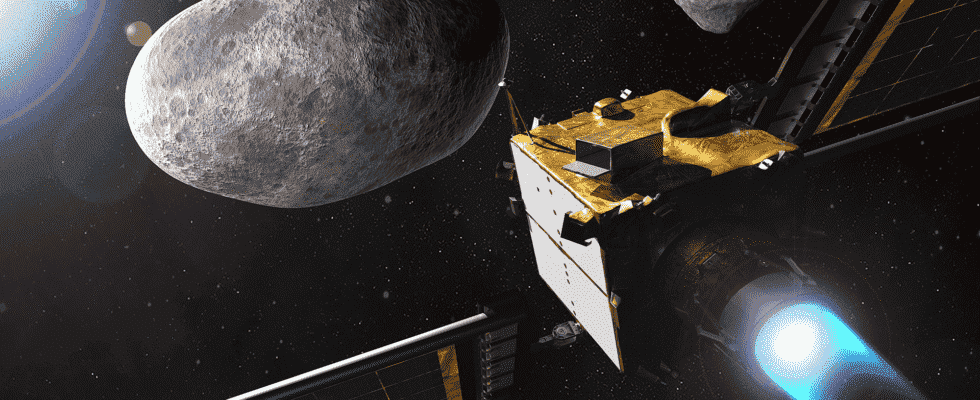At 1:14 a.m., theDART impactor of NASA will collide with the small moon Dimorphos, which revolves around its asteroid Didymos. The probe still has all day to make the final trajectory changes, while the ground stations prepare for an intense observation campaign.
And that includes the small LICIACube vehicle dropped a few days ago!
Live here.
It’s not the time to miss out
160 meters. This is the approximate diameter of the asteroid Dimorphos. The DART probe (Double Asteroid Redirect Test) from NASA is now heading towards it at the phenomenal speed of 23,760 km/h… Suffice to say that you should not miss it! For this, the probe relies on its DRACO optical system, capable for more than a month of seeing the main asteroid of the targeted duo, Didymos (about 800 m in diameter), and on its extremely precise thrusters to adjust its trajectory.
Until the evening of September 26, it is the mission teams who are directing the impactor, depending on the estimated position of the asteroid and its small moon Dimorphos… But in the last four hours, it is DART herself who will manage her movements and guide herself towards her objective. Everything will go very quickly! Four minutes before impact, it will still be 1600 km from the rocky surface of its target. NASA has already planned a live broadcast and the images from the probe promise to be spectacular.
Full ahead!
Until impact, the DART mission and its 550 kg are essentially a technological demonstration: since its takeoff on November 24, 2021 the probe has accelerated and then adjusted its trajectory to be there in the right place and at the right time. But tonight won’t be so much about hitting the moon with an asteroid as observing its effects. It is indeed a first draft of “planetary defense”, a pompous but nevertheless correct term, in case we discover one day (this is not the case so far) an asteroid threatening our planet.
The deflection of an asteroid by impact is the simplest track to make it change its trajectory, the energy of the collision modifying the orbital movement of the asteroid. And in the grand orbital scheme a few fractions of m/s may be enough to avoid a future big planetary annoyance. Many telescopes will therefore observe the small moon Dimorphos before, during and especially after the impact with DART.
Look for asteroid images!
The first spectator will be the CubeSat 6U (10 x 20 x 30 cm) LICIACube, which separated from DART on September 11 and maneuvered to position itself about 50 km from the impactor. The latter will use its two optical devices LUKE (color, 1M Pixel) and LEIA (B&W, 4M Pixel) to photograph the scene in real time and transmit its photos to Earth. This is probably the CubeSat with the most important mission so far, with the possible exception of the CAPSTONE mission.
Many other missions will observe Didymos and Dimorphos: the Lucy probe which approaches the Earth for its gravitational assistance in October, Hubble and even the Webb telescope. But on Earth too, a whole network of telescopes is mobilized to obtain the most precise images and the best information on the (small) expected change in trajectory of Dimorphos (and possibly the column of ejected material, if the latter is large).
A useful reminder, impact with Dimorphos has absolutely no risk of sending the asteroid, its small moon, or the debris towards Earth.
Source : CNET

6